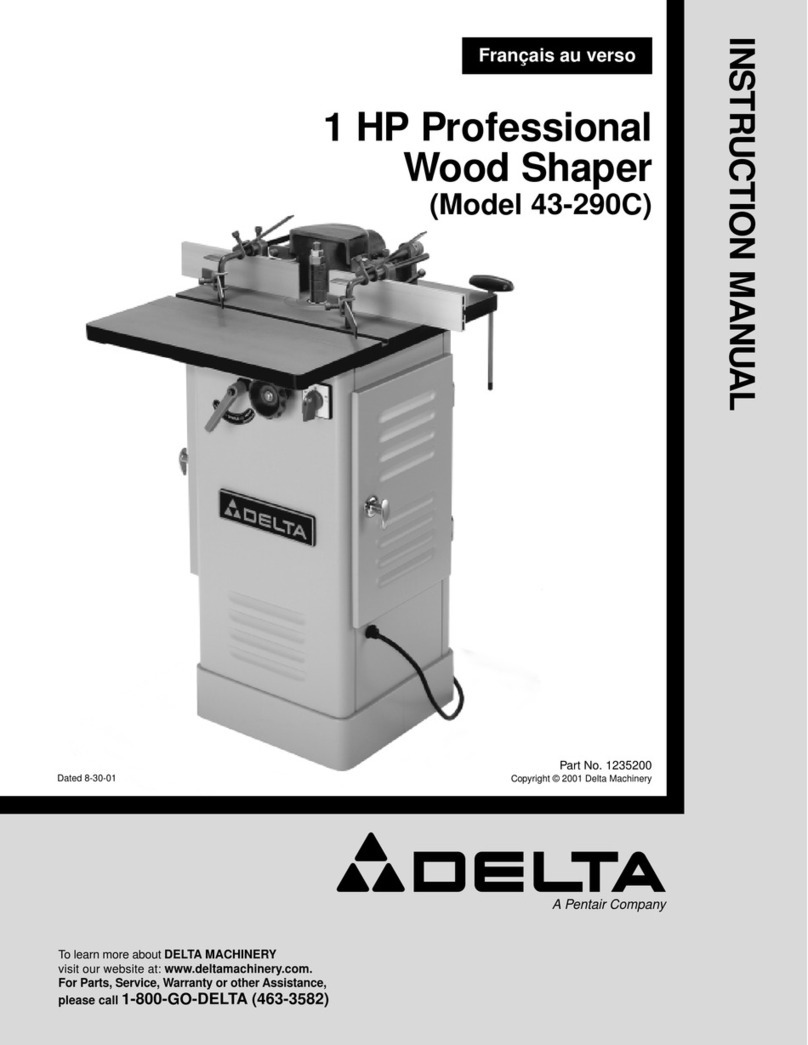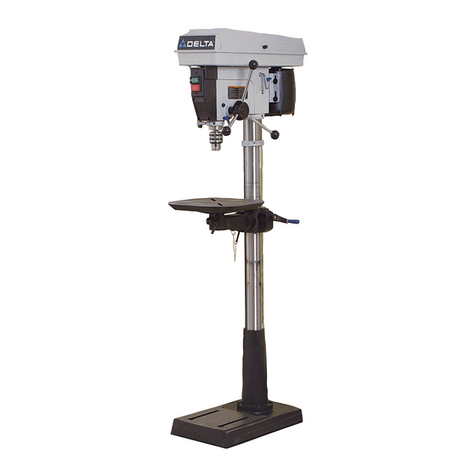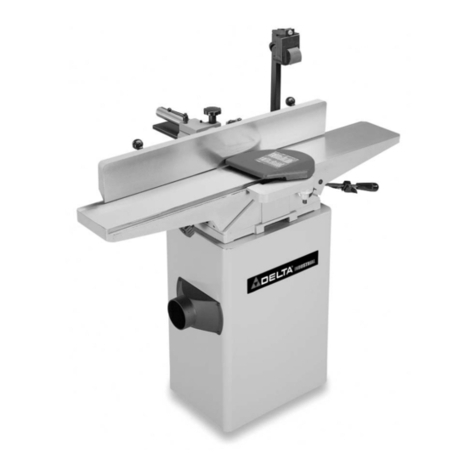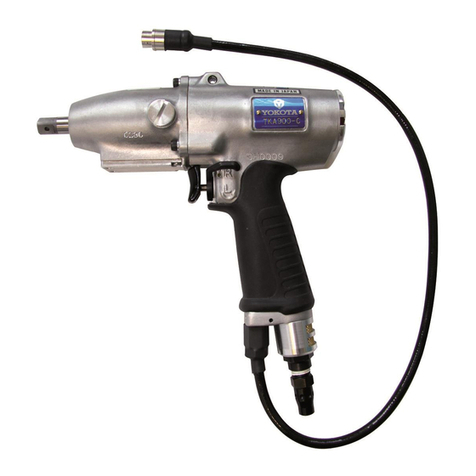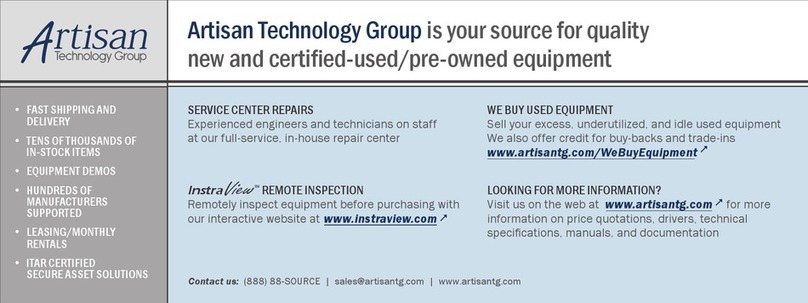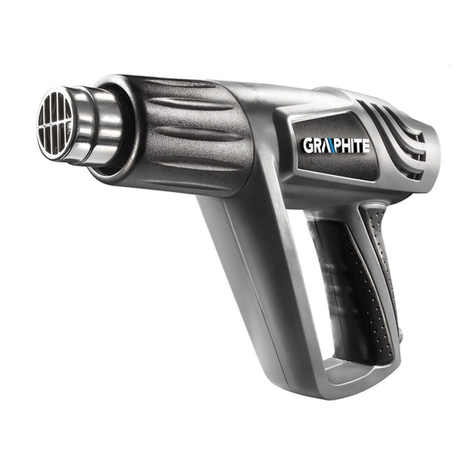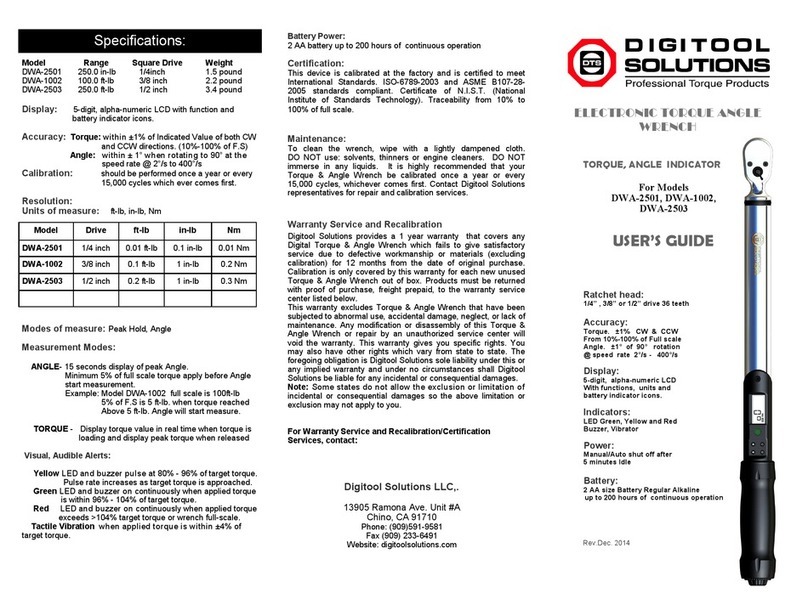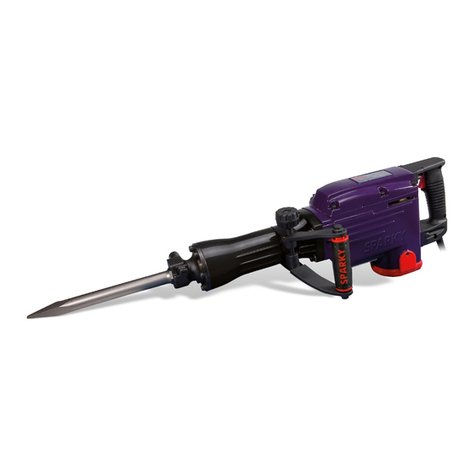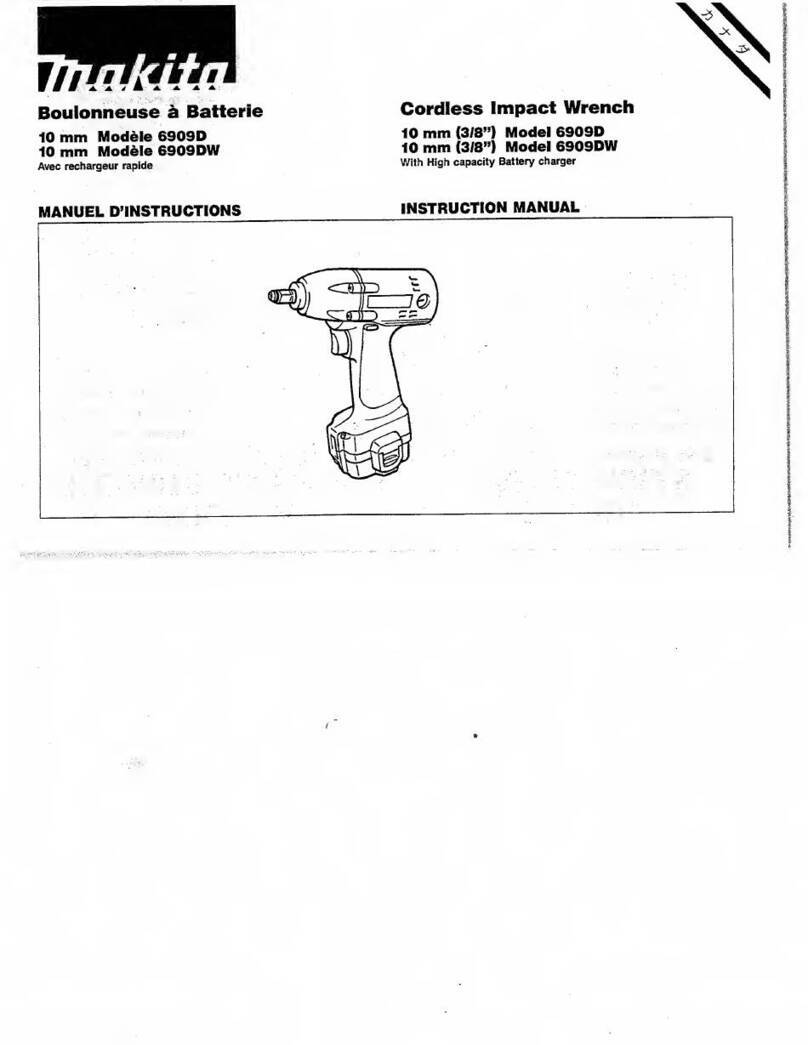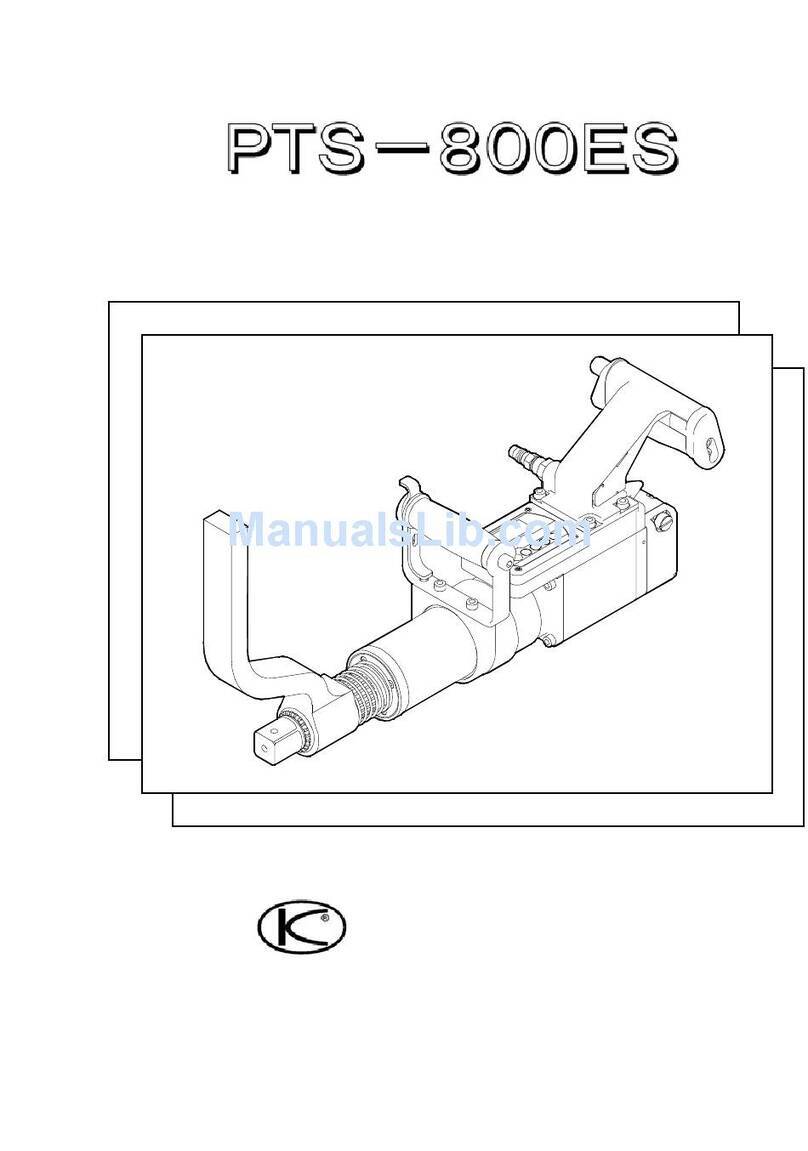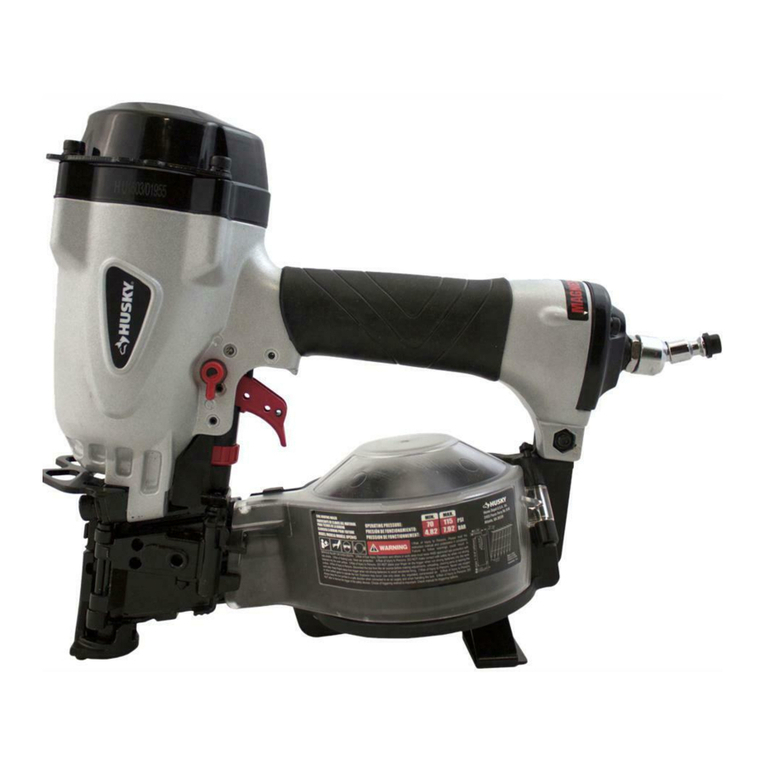Delta 37-380 User manual

INSTRUCTION MANUAL
8" Professional Jointer
(Model 37-380)
PART NO. 909568 - 07-10-03
Copyright © 2003 Delta Machinery
To learn more about DELTA MACHINERY
visit our website at: www.deltamachinery.com.
For Parts, Service, Warranty or other Assistance,
please call 1-800-223-7278 (In Canada call 1-800-463-3582).

2
Indicates an imminently hazardous situation which, if not avoided, will result in death or serious injury.
Indicates a potentially hazardous situation which, if not avoided, could result in death or serious injury.
Indicates a potentially hazardous situation which, if not avoided, may result in minor or moderate injury.
Used without the safety alert symbol indicates potentially hazardous situation which, if not avoided, may
result in property damage.
This manual contains information that is important for you to know and understand. This information relates to protect-
ing YOUR SAFETY and PREVENTING EQUIPMENT PROBLEMS. To help you recognize this information, we use the
symbols to the right. Please read the manual and pay attention to these sections.
SAFETY GUIDELINES - DEFINITIONS
SOME DUST CREATED BY POWER SANDING, SAWING, GRINDING, DRILLING, AND OTHER
CONSTRUCTION ACTIVITIES contains chemicals known to cause cancer, birth defects or other reproductive harm.
Some examples of these chemicals are:
· lead from lead-based paints,
· crystalline silica from bricks and cement and other masonry products, and
· arsenic and chromium from chemically-treated lumber.
Your risk from these exposures varies, depending on how often you do this type of work. To reduce your exposure to
these chemicals: work in a well ventilated area, and work with approved safety equipment, always wear MSHA/NIOSH
approved, properly fitting face mask or respirator when using such tools.
GENERAL SAFETY RULES
READ AND UNDERSTAND ALL WARNINGS AND OPERATING INSTRUCTIONS BEFORE
USING THIS EQUIPMENT. Failure to follow all instructions listed below, may result in electric shock,
fire, and/or serious personal injury or property damage.
IMPORTANT SAFETY INSTRUCTIONS
Woodworking can be dangerous if safe and proper operating procedures are not followed. As with all machinery, there
are certain hazards involved with the operation of the product. Using the machine with respect and caution will
considerably lessen the possibility of personal injury. However, if normal safety precautions are overlooked or ignored,
personal injury to the operator may result. Safety equipment such as guards, push sticks, hold-downs, featherboards,
goggles, dust masks and hearing protection can reduce your potential for injury. But even the best guard won’t make
up for poor judgment, carelessness or inattention. Always use common sense and exercise caution in the workshop.
If a procedure feels dangerous, don’t try it. Figure out an alternative procedure that feels safer. REMEMBER: Your
personal safety is your responsibility. For additional information please visit our website www.deltamachinery.com.
This machine was designed for certain applications only. Delta Machinery strongly recommends that this
machine not be modified and/or used for any application other than that for which it was designed. If you have any
questions relative to a particular application, DO NOT use the machine until you have first contacted Delta to determine
if it can or should be performed on the product.
Technical Service Manager
Delta Machinery
4825 Highway 45 North
Jackson, TN 38305
(IN CANADA: 505 SOUTHGATE DRIVE, GUELPH, ONTARIO N1H 6M7)

3
FAILURE TO FOLLOW THESE RULES MAY RESULT IN SERIOUS PERSONAL INJURY.
1. FOR YOUR OWN SAFETY, READ THE INSTRUC-
TION MANUAL BEFORE OPERATING THE
MACHINE. Learning the machine’s application,
limitations, and specific hazards will greatly
minimize the possibility of accidents and injury.
2. USE CERTIFIED SAFETY EQUIPMENT. Eye
protection equipment should comply with ANSI
Z87.1 standards, hearing equipment should
comply with ANSI S3.19 standards, and dust mask
protection should comply with MSHA/NIOSH
certified respirator standards. Splinters, air-borne
debris, and dust can cause irritation, injury, and/or
illness.
3. DRESS PROPERLY. Do not wear tie, gloves, or
loose clothing. Remove watch, rings, and other
jewelry. Roll up your sleeves. Clothing or jewelry
caught in moving parts can cause injury.
4. DO NOT USE THE MACHINE IN A DANGEROUS
ENVIRONMENT. The use of power tools in damp
or wet locations or in rain can cause shock or
electrocution. Keep your work area well-lit to
prevent tripping or placing arms, hands, and
fingers in danger.
5. MAINTAIN ALL TOOLS AND MACHINES IN PEAK
CONDITION. Keep tools sharp and clean for best and
safest performance. Follow instructions for lubricating
and changing accessories. Poorly maintained tools and
machines can further damage the tool or machine and/or
cause injury.
6. CHECK FOR DAMAGED PARTS. Before using the
machine, check for any damaged parts. Check for
alignment of moving parts, binding of moving
parts, breakage of parts, and any other conditions
that may affect its operation. A guard or any other
part that is damaged should be properly repaired
or replaced. Damaged parts can cause further
damage to the machine and/or injury.
7. KEEP THE WORK AREA CLEAN. Cluttered areas and
benches invite accidents.
8. KEEP CHILDREN AND VISITORS AWAY. Your shop is
a potentially dangerous environment. Children and visitors
can be injured.
9. REDUCE THE RISK OF UNINTENTIONAL STARTING.
Make sure that the switch is in the “OFF” position
before plugging in the power cord. In the event of
a power failure, move the switch to the “OFF”
position. An accidental start-up can cause injury.
10. USE THE GUARDS. Check to see that all guards
are in place, secured, and working correctly to
prevent injury.
11. REMOVE ADJUSTING KEYS AND WRENCHES
BEFORE STARTING THE MACHINE. Tools, scrap
pieces, and other debris can be thrown at high
speed, causing injury.
12. USE THE RIGHT MACHINE. Don’t force a
machine or an attachment to do a job for which it
was not designed. Damage to the machine and/or
injury may result.
13. USE RECOMMENDED ACCESSORIES. The use
of accessories and attachments not recom-
mended by Delta may cause damage to the
machine or injury to the user.
14. USE THE PROPER EXTENSION CORD. Make
sure your extension cord is in good condition.
When using an extension cord, be sure to use one
heavy enough to carry the current your product will
draw. An undersized cord will cause a drop in line
voltage, resulting in loss of power and overheating.
See the Extension Cord Chart for the correct size
depending on the cord length and nameplate
ampere rating. If in doubt, use the next heavier
gauge. The smaller the gauge number, the heavier
the cord.
15. SECURE THE WORKPIECE. Use clamps or a vise to
hold the workpiece when practical. Loss of control
of a workpiece can cause injury.
16. FEED THE WORKPIECE AGAINST THE DIRECTION
OF THE ROTATION OF THE BLADE, CUTTER, OR
ABRASIVE SURFACE. Feeding it from the other
direction will cause the workpiece to be thrown out
at high speed.
17. DON’T FORCE THE WORKPIECE ON THE
MACHINE. Damage to the machine and/or injury
may result.
18. DON’T OVERREACH. Loss of balance can make
you fall into a working machine, causing injury.
19. NEVER STAND ON THE MACHINE. Injury could occur if
the tool tips, or if you accidentally contact the cutting tool.
20. NEVER LEAVE THE MACHINE RUNNING UNATTEN-
DED. TURN THE POWER OFF. Don’t leave the machine
until it comes to a complete stop. A child or visitor could
be injured.
21. TURN THE MACHINE “OFF”, AND DISCONNECT THE
MACHINE FROM THE POWER SOURCE before
installing or removing accessories, before adjusting
or changing set-ups, or when making repairs. An
accidental start-up can cause injury.
22. MAKE YOUR WORKSHOP CHILDPROOF WITH
PADLOCKS, MASTER SWITCHES, OR BY
REMOVING STARTER KEYS. The accidental
start-up of a machine by a child or visitor could
cause injury.
23. STAY ALERT, WATCH WHAT YOU ARE DOING,
AND USE COMMON SENSE. DO NOT USE THE
MACHINE WHEN YOU ARE TIRED OR UNDER
THE INFLUENCE OF DRUGS, ALCOHOL, OR
MEDICATION. A moment of inattention while
operating power tools may result in injury.
24. THE DUST GENERATED by certain woods and
wood products can be injurious to your health.
Always operate machinery in well-ventilated areas,
and provide for proper dust removal. Use wood
dust collection systems whenever possible.

4
ADDITIONAL SAFETY RULES
FOR JOINTERS
1. DO NOT OPERATE THIS MACHINE until it is
completely assembled and installed according to
the instructions. A machine incorrectly assembled
can cause serious injury.
2. OBTAIN ADVICE from your supervisor, instructor,
or another qualified person if you are not
thoroughly familiar with the operation of this
machine. Knowledge is safety.
3. FOLLOW ALL WIRING CODES and
recommended electrical connections to prevent
shock or electrocution.
4. KEEP KNIVES SHARP and free from rust and
pitch. Dull or rusted knives work harder and can
cause kickback.
5. TIGHTEN THE INFEED/OUTFEED TABLES before
starting the machine. Loss of control of the work-
piece can cause serious injury.
6. PROPERLY SECURE THE BLADES IN THE
CUTTERHEAD before turning the power “ON”.
Loose blades may be thrown out at high speeds.
7. NEVER TURN THE MACHINE “ON” before clearing
the table of all objects (tools, scraps of wood, etc.).
Flying debris can cause serious injury.
8. NEVER TURN THE MACHINE “ON” with the
workpiece contacting the cutterhead. Kickback
can occur.
9. AVOID AWKWARD OPERATIONS AND HAND
POSITIONS. A sudden slip could cause a hand to
move into the cutterhead.
10. KEEP ARMS, HANDS, AND FINGERS away from
the cutterhead to prevent severe injury.
11. NEVER MAKE CUTS deeper than 1/8" (3.2mm) to
prevent kickback.
12. NEVER JOINT OR PLANE A WORKPIECE that is
shorter than 10" (254mm), narrower than 3/4"
(19.0MM), or less than 1/2" (12.7mm) thick.
Jointing smaller workpieces can place your hand
in the cutterhead causing severe injury.
13. USE HOLD-DOWN/PUSH BLOCKS for jointing or
planing any workpiece lower than the fence.
Jointing or planing small workpieces can result in
kickback and severe injury.
14. HOLD THE WORKPIECE FIRMLY against the
table and fence. Loss of control of the workpiece
can cause kickback and result in serious injury.
15. NEVER PERFORM “FREE-HAND” OPERATIONS.
Use the fence to position and guide the
workpiece. Loss of control of the workpiece can
cause serious injury.
16. DO NOT attempt to perform an abnormal or little-
used operation without study and the use of
adequate hold-down/push blocks, jigs, fixtures,
stops, etc.
17. DO NOT FEED A WORKPIECE into the outfeed
end of the machine.The workpiece will be thrown
out of the opposite end at high speeds.
18. DO NOT FEED A WORKPIECE that is warped,
contains knots, or is embedded with foreign
objects (nails, staples, etc.) to prevent kickback.
19. MAINTAIN THE PROPER RELATIONSHIP OF
INFEED AND OUTFEED TABLE SURFACES and
cutterhead knife path. Loss of control of the work-
piece can cause serious injury.
20. PROPERLY SUPPORT LONG OR WIDE
WORKPIECES. Loss of control of the workpiece can
cause injury.
21. NEVER PERFORM LAYOUT, ASSEMBLY, OR SET-
UP WORK on the table/work area when the
machine is running. A sudden slip could cause a
hand to move into the cutterhead. Severe injury
can result.
22. TURN THE MACHINE “OFF”, disconnect the
machine from the power source, and clean the
table/work area before leaving the machine.
LOCK THE SWITCH IN THE “OFF” POSITION to
prevent unauthorized use. Someone else might
accidentally start the machine and cause injury to
themselves.
23. ADDITIONAL INFORMATION regarding the safe
and proper operation of power tools (i.e. a safety
video) is available from the Power Tool Institute,
1300 Sumner Avenue, Cleveland, OH 44115-2851
(www.powertoolinstitute.com). Information is also
available from the National Safety Council, 1121
Spring Lake Drive, Itasca, IL 60143-3201. Please
refer to the American National Standards Institute
ANSI 01.1 Safety Requirements for Woodworking
Machines and the U.S. Department of Labor
OSHA 1910.213 Regulations.
FAILURE TO FOLLOW THESE RULES MAY RESULT IN SERIOUS INJURY.
SAVE THESE INSTRUCTIONS.
Refer to them often and use them to instruct others.

5
A separate electrical circuit should be used for your machines. This circuit should not be less than #12 wire and should
be protected with a 20 Amp time lag fuse. If an extension cord is used, use only 3-wire extension cords which have 3-
prong grounding type plugs and matching receptacle which will accept the machine’s plug. Before connecting the
machine to the power line, make sure the switch is in the “OFF” position and be sure that the electric current is of the
same characteristics as indicated on the machine. All line connections should make good contact. Running on low
voltage will damage the machine.
DO NOT EXPOSE THE MACHINE TO RAIN OR OPERATE THE MACHINE IN DAMP LOCATIONS.
Your machine is wired for 120 volt, 60 HZ alternating current. Before connecting the machine to the power source, make
sure the switch is in the “OFF” position.
THIS MACHINE MUST BE GROUNDED WHILE IN USE TO PROTECT THE OPERATOR FROM
ELECTRIC SHOCK.
MOTOR SPECIFICATIONS
GROUNDED OUTLET BOX
CURRENT
CARRYING
PRONGS
GROUNDING BLADE
IS LONGEST OF THE 3 BLADES
GROUNDED OUTLET BOX
GROUNDING
MEANS
ADAPTER
2. Grounded, cord-connected machines intended for use
on a supply circuit having a nominal rating less than 150
volts:
If the machine is intended for use on a circuit that has an
outlet that looks like the one illustrated in Fig. A,the
machine will have a grounding plug that looks like the plug
illustrated in Fig. A. A temporary adapter, which looks like
the adapter illustrated in Fig. B, may be used to connect
this plug to a matching 2-conductor receptacle as shown
in Fig. B if a properly grounded outlet is not available. The
temporary adapter should be used only until a properly
grounded outlet can be installed by a qualified electrician.
The green-colored rigid ear, lug, and the like, extending
from the adapter must be connected to a permanent
ground such as a properly grounded outlet box. Whenever
the adapter is used, it must be held in place with a metal
screw.
NOTE: In Canada, the use of a temporary adapter is not
permitted by the Canadian Electric Code.
3. Grounded, cord-connected machines intended for use
on a supply circuit having a nominal rating between 150
- 250 volts, inclusive:
If the machine is intended for use on a circuit that has an
outlet that looks like the one illustrated in Fig. C, the
machine will have a grounding plug that looks like the
plug illustrated in Fig. C. Make sure the machine is
connected to an outlet having the same configuration as
1. All grounded, cord-connected machines:
In the event of a malfunction or breakdown, grounding
provides a path of least resistance for electric current to
reduce the risk of electric shock. This machine is
equipped with an electric cord having an equipment-
grounding conductor and a grounding plug. The plug must
be plugged into a matching outlet that is properly installed
and grounded in accordance with all local codes and
ordinances.
Do not modify the plug provided - if it will not fit the outlet,
have the proper outlet installed by a qualified electrician.
Improper connection of the equipment-grounding
conductor can result in risk of electric shock. The
conductor with insulation having an outer surface that is
green with or without yellow stripes is the equipment-
grounding conductor. If repair or replacement of the
electric cord or plug is necessary, do not connect the
equipment-grounding conductor to a live terminal.
Check with a qualified electrician or service personnel if
the grounding instructions are not completely
understood, or if in doubt as to whether the machine is
properly grounded.
Use only 3-wire extension cords that have 3-prong
grounding type plugs and matching 3-conductor
receptacles that accept the machine’s plug, as shown in
Fig. A.
Repair or replace damaged or worn cord immediately.
POWER CONNECTIONS
GROUNDING INSTRUCTIONS
Fig. A Fig. B

6
Use proper extension cords. Make sure your extension cord is in good condition and is a 3-wire
extension cord which has a 3-prong grounding type plug and matching receptacle which will accept the machine’s
plug. When using an extension cord, be sure to use one heavy enough to carry the current of the machine. An
undersized cord will cause a drop in line voltage, resulting in loss of power and overheating. Fig. D, shows the correct
gauge to use depending on the cord length. If in doubt, use the next heavier gauge. The smaller the gauge number,
the heavier the cord.
EXTENSION CORDS
FOREWORD
Delta Model 37-380 is a 8" Professional Jointer with a cutting capacity of 8" (203mm) width, 1/8" depth (3mm max.) and
1/2" (13mm) rabbeting. Unit includes; heavy-duty 1-1/2 hp, 120/240 volt induction motor, stand, dust chute, fence, three-
knife cutterhead, cutterhead guard, and push blocks.
Carefully unpack the machine and all loose items from the shipping container(s). Remove the protective coating from
all unpainted surfaces. This coating may be removed with a soft cloth moistened with kerosene (do not use acetone,
gasoline or lacquer thinner for this purpose). After cleaning, cover the unpainted surfaces with a good quality household
floor paste wax.
NOTICE: THE MANUAL COVER PHOTO ILLUSTRATES THE CURRENT
PRODUCTION MODEL. ALL OTHER ILLUSTRATIONS ARE REPRESENTATIVE
ONLY AND MAY NOT DEPICT THE ACTUAL COLOR, LABELING OR
ACCESSORIES AND MAY BE INTENDED TO ILLUSTRATE TECHNIQUE ONLY.
Fig. D Fig. D
MINIMUM GAUGE EXTENSION CORD
RECOMMENDED SIZES FOR USE WITH STATIONARY ELECTRIC MACHINES
Ampere Total Length Gauge of
Rating Volts of Cord in Feet Extension Cord
0-6 120
up to
25 18 AWG
0-6 120 25-50 16 AWG
0-6 120 50-100 16 AWG
0-6 120 100-150 14 AWG
6-10 120
up to
25 18 AWG
6-10 120 25-50 16 AWG
6-10 120 50-100 14 AWG
6-10 120 100-150 12 AWG
10-12 120
up to
25 16 AWG
10-12 120 25-50 16 AWG
10-12 120 50-100 14 AWG
10-12 120 100-150 12 AWG
12-16 120
up to
25 14 AWG
12-16 120 25-50 12 AWG
12-16 120 GREATER THAN 50 FEET NOT RECOMMENDED
MINIMUM GAUGE EXTENSION CORD
RECOMMENDED SIZES FOR USE WITH STATIONARY ELECTRIC MACHINES
Ampere Total Length Gauge of
Rating Volts of Cord in Feet Extension Cord
0-6 240
up to
50 18 AWG
0-6 240 50-100 16 AWG
0-6 240 100-200 16 AWG
0-6 240 200-300 14 AWG
6-10 240
up to
50 18 AWG
6-10 240 50-100 16 AWG
6-10 240 100-200 14 AWG
6-10 240 200-300 12 AWG
10-12 240
up to
50 16 AWG
10-12 240 50-100 16 AWG
10-12 240 100-200 14 AWG
10-12 240 200-300 12 AWG
12-16 240
up to
50 14 AWG
12-16 240 50-100 12 AWG
12-16 240
GREATER THAN 100 FEET NOT RECOMMENDED
Fig. C
GROUNDED OUTLET BOX
CURRENT
CARRYING
PRONGS
GROUNDING BLADE
IS LONGEST OF THE 3 BLADES
the plug. No adapter is available or should be used with
this machine. If the machine must be re-connected for
use on a different type of electric circuit, the re-
connection should be made by qualified service
personnel; and after re-connection, the machine should
comply with all local codes and ordinances.
IN ALL CASES, MAKE CERTAIN
THE RECEPTACLE IN QUESTION IS PROPERLY
GROUNDED. IF YOU ARE NOT SURE HAVE A
QUALIFIED ELECTRICIAN CHECK THE
RECEPTACLE.
OPERATING INSTRUCTIONS
UNPACKING AND CLEANING

7
JOINTER PARTS
Fig. 2
1. Jointer
2. Fence Carriage Assembly
3. Cutterhead Pulley Guard/Carriage Mounting Bracket
4. Table Raising Handle
5. Switch Mounting Bracket
6. Cutterhead Guard
7. Fence Tilting Handles (2)
8. Fence
9. Push Blocks (2)
10. 6mm Hex Wrench
11. 4mm Hex Wrench
12. 3mm Hex Wrench
13. 2.5mm Hex Wrench
14. 12-14mm Open End Wrench
15. 8-10mm Open End Wrench
1
2
3
4
5
67
8
9
10 11
12
13
14 15

8
Fig. 3
16. Stand with Pre-Wired Switch
17. Dust Chute
18. V-Belt
19. Pulley
20. 3/8-16x2" Hex Head Screw (3)
21. M8x1.25x55mm Hex Socket Head Screw (4)
22. M8x1.25x25mm Hex Socket Head Screw (2)
23. M8x1.25x20mm Hex Socket Head Screw (2)
24. M8x1.25x16mm Hex Socket Head Screw (2)
25. 5/16-18x1" Hex Head Screw (1)
26. #10-16x1/2" Sheet Metal Screw (4)
27. 3/8" Flat Washer (6)
28. 11/32" Flat Washer (1)
29. M8 Flat Washer (10)
30. 3/8" Lockwasher (3)
31. M8.1 Lockwasher (10)
32. 5/16" Lockwasher (1)
33. M14x2 Hex Nut (1)
34. 3/8-16" Hex Nut (3)
35. 5/16-18 Hex Nut (1)
36. Key
16
17
18 19
20
21
22
23
24
25
26
27
28
29
30
31
32
34
35
36
ASSEMBLY
FOR YOUR OWN SAFETY, DO NOT CONNECT THE MACHINE TO THE POWER SOURCE UNTIL
THE MACHINE IS COMPLETELY ASSEMBLED AND YOU READ AND UNDERSTAND THE ENTIRE
INSTRUCTION MANUAL.
Fig. 4
JOINTER TO STAND
Your Jointer stand (A) Fig. 4, is shipped with the motor
and switch completely wired.
NOTE: THE MOTOR IS BOLTED TO THE TOP OF THE
STAND AND MUST BE ATTACHED TO THE MOTOR
MOUNTING BRACKETS.
1. Remove the six screws (C) Fig. 4. Then remove back
panel (E) from the stand.
33
C
C
E

9
2. Remove the four bolts that attach the motor (A) Fig.
5 to top of the stand. NOTE: SAVE THESE BOLTS AS
THEY WILL BE USED TO ATTACH THE MOTOR TO
THE MOUNTING BRACKETS.
Fig. 5
5. Line up three holes (F) and (L) Fig. 6, on top of stand
with three holes located at the bottom of the jointer
base. Place a 3/8" flat washer (H) Fig. 7, on a 3/8-16x2"
hex head screw (G), insert the screw through the hole in
the base of the Jointer and hole (F) Fig. 6, in the stand.
Place a 3/8" flat washer (H) Fig. 7, 3/8" lockwasher (J),
and thread a 3/8-16 hex nut (K) onto the screw and
tighten securely. Repeat this process for the remaining
hole (F) in the stand and Jointer base. Repeat this
process for hole (L) in the stand and Jointer base by
inserting the screw up through hole (L) in the stand and
the Jointer base.
Fig. 6
F
L
THE JOINTER IS EXTREMELY HEAVY.
HAVE TWO OR MORE PEOPLE LIFT THE MACHINE
ONTO THE STAND OR LIFT THE JOINTER
MECHANICALLY.
Fig. 7
G
H
J
K
Fig. 8
ASSEMBLING INFEED TABLE
ADJUSTMENT HANDLE
1. Thread an M14x2 hex nut (A) Fig. 8, clockwise onto
the end of adjustment handle (B) as far as it will go.
2. Thread handle (B) Fig. 8, into block (C) which is
located under infeed table (D). Tighten hex nut (A) Fig. 8,
against block (C).
DB
A
C
A
3. Align the holes in the motor mounting plate (B) Fig.
5A with the four holes in the two motor mounting
brackets (C). Attach the motor to the motor mounting
brackets with the hardware that was removed in STEP 2.
NOTE: MAKE SURE THAT MOTOR SHAFT (D) FIG 5A
IS FACING OUT OF THE OPENING IN THE MOTOR
CABINET AS SHOWN.
4. Turn the stand over so that it is resting on its base
as shown in Fig. 6.
Fig. 5A
B
C
D

10
ASSEMBLING
MOTOR PULLEY
Assemble motor pulley (K) Fig. 10, to motor shaft with
the hub of the pulley in the outer position as shown.
Make certain key (L) is inserted in the keyway of the
pulley and motor shaft, then tighten set screw (M) using
the 3 mm hex wrench (not shown).
Fig. 10
K
L
M
ASSEMBLING BELT AND
ALIGNING PULLEYS
1. Place belt (A) Fig. 11, in groove of cutterhead pulley
(B) and motor pulley (C).
2. Make certain the motor pulley (C) Figs. 11 and 12, is
properly aligned with cutterhead pulley (B) by placing a
straight edge (D) Fig. 12, onto the face of each pulley as
shown.
3. If an adjustment is needed, the motor pulley can be
moved in or out on the motor shaft, or the motor can be
shifted by loosening motor mounting screws, two of
which are shown at (E) Fig. 12. After adjustments are
made, tighten motor mounting hardware and motor
pulley set screw.
Fig. 11
Fig. 12
A
C
B
E
A
B
C
D
ADJUSTING BELT TENSION
1. Correct belt tension is obtained when there is
approximately 1" deflection at the center span of the
belt using light finger pressure.
2. If an adjustment is required, the motor can be raised
or lowered to obtain the correct belt tension.
3. Tighten motor mounting hardware after tension is
applied, making sure alignment of the pulleys is not
disturbed.
4. Re-attach back panel of stand which was removed
in STEP 2 of “ASSEMBLING JOINTER TO STAND”.
Fig. 13
B
B
A
A
C
ASSEMBLING CUTTERHEAD
PULLEY GUARD/
CARRIAGE BRACKET
1. Position two alignment pins (A) Fig. 13, with two
alignment holes (B) in jointer base.

11
2. Using the supplied 6mm hex wrench (E) Fig. 14,
fasten bracket (C) onto jointer base (G). Place a M8.1
lockwasher then an M8 flat washer on an M8x1.25x55mm
hex socket head screw. Insert the screw (D) Fig. 14,
through the hole in bracket (C), and thread the screw into
the jointer base (G), and tighten securely. Repeat this
process for the three remaining holes in the bracket and
jointer.
Fig. 14
DD
CE
G
ASSEMBLING FENCE
CARRIAGE ASSEMBLY
1. Fasten fence carriage assembly (A) Fig. 15, to
cutterhead pulley guard/carriage mounting bracket (C).
Align the holes in the fence carriage assembly (A) one of
which is shown at (D), with the holes in the pulley
guard/carriage mounting bracket (C). Place a M8.1
lockwasher (E), then an M8 flat washer on an
M8x1.25x20mm hex socket head screw (B). Insert the
screw through the hole in the fence carriage assembly,
and thread the screw into the tapped hole in the
cutterhead pulley guard/carriage mounting bracket and
tighten securely. Repeat this process for the remaining
hole in the fence carriage assembly and the cutterhead
pulley guard/carriage mounting bracket.
2. Fig. 16, illustrates fence carriage assembly properly
mounted.
Fig. 15
A
D
C
B
E
F
Fig. 16
ASSEMBLING FENCE
1. Fasten fence (A) Fig. 17, to fence carriage assembly
(C) through holes (D). Align the two holes (G) in the fence
with the two holes (D) in the carriage assembly (C). Place
a M8.1 lockwasher (E), then an M8 flat washer (F), on an
M8x1.25x25mm hex socket head screw (B). Insert the
screw through hole (D) in the carriage assembly and
thread the screw into the tapped hole (G) in the fence,
and tighten securely. Repeat this process for the
remaining hole in the fence and carriage assembly. Fig. 17
AG
D
C
B
EF
D

12
2. Fig. 18 illustrates fence properly mounted.
Fig. 18
3. Thread shorter fence handle (E ) Fig.19, into infeed
end of fence (A) and longer fence handle (G) into outfeed
end as shown.
Fig. 19
E
G
A
ASSEMBLING
CUTTERHEAD GUARD
1. Remove set screw (not shown) from cutterhead
guard post (F) with the 2.5mm hex wrench. Insert post
(F) through hole in the infeed table. NOTE: A spring is
supplied in knob assembly (E) that returns the guard (C)
over the cutterhead after a cut has been made. Turn
knob (E) counter-clockwise to provide tension on the
spring before inserting post (F). Make certain the spring
engages in the slot of the post. If spring tension is too
tight or too loose, adjust the spring accordingly by
removing the guard and rotating knob (E).
2. Thread set screw (B) Fig. 21 back into post (F) Fig.
20, to keep cutterhead guard (C) in position during
jointer operation.
3. Fig. 21, illustrates the cutterhead guard (C)
assembled to the infeed table.
Fig. 20
F
E
C
Fig. 21
B
C

13
ASSEMBLING SWITCH AND
MOUNTING BRACKET
1. Align the two holes in the switch mounting bracket
(A) Fig 22, with the two holes (D) in the back of the infeed
table (B). Place an M8.1 lockwasher (E) Fig. 22, then an
M8 flat washer (F), on an M8x1.25x16mm hex socket
head screw (C). Insert the screw through the hole (D) Fig.
22, in the switch mounting bracket (A) and thread the
screw into the tapped hole in the back of the infeed table
(B), and tighten securely. Repeat this process for the
remaining hole in the switch mounting bracket and the
infeed table.
2. Align the hole (E) Fig. 23 in the switch, with the hole
(G) in the mounting bracket. Place an 11/32" flat washer
(I) Fig. 23, on a 5/16-18x1" hex head screw (H). Insert the
screw through the hole in switch (E) and hole (G) in the
mounting bracket. Place a 5/16" lockwasher (J) on
screw (H). Thread a 5/16-18 hex nut (K) on the screw
and tighten securely.
3. Fig. 24, illustrates the switch properly mounted.
Fig. 22
Fig. 23
Fig. 24
A
D
D
B
E
F
C
E
G
I
H
JK
Fig. 25 Fig. 26
ASSEMBLING DUST CHUTE
The jointer stand has a built-in dust chute (A) Fig. 25. If
this machine is to be used with a dust collection system,
the supplied dust collector connector (B) Fig. 26, can be
fastened to jointer stand (C) with four #10-16x1/2" sheet
metal screws (D) as shown.
A standard 4" dust collection hose can be attached to
dust collector connector.
A
DB
C

14
OPERATING CONTROLS AND ADJUSTMENTS
STARTING AND STOPPING
JOINTER
1. The on/off switch is located underneath the switch
shield (B) Fig. 31. To start the jointer, move switch (A) up
to the “ON” position.
2. To turn the jointer “OFF”, push down on switch
shield (B) Fig. 32, as shown.
Fig. 31
B
A
Fig. 32
B
LOCKING SWITCH
IN THE “OFF” POSITION
IMPORTANT: When the tool is not in use, the switch
should be locked in the “OFF” position to prevent
unauthorized use. Insert the shank of padlock (C) Fig.
33, through the holes in the switch plate to lock the
on/off switch trigger (A).
Fig. 33
C
A
INFEED TABLE
ADJUSTMENTS
1. To raise or lower the infeed table, loosen table
locking handle (A) Fig. 34, which is located at the rear of
the infeed table and loosen locking handle (B) Fig. 35,
which is located at the front of the infeed table.
Fig. 34
A

15
2. Raise or lower the infeed table adjustment lever (C)
Fig. 35.
3. IMPORTANT: When lowering the infeed table, a
depth stop (D) Fig. 35, will automatically stop the table
at a 1/8" depth-of-cut. To move the table past this point,
the depth stop (D) Fig. 36, must be raised, while
simultaneously lowering the infeed table. Always make
certain table locking handles (A) Fig. 34, and (B) Fig. 35,
are tight before operating the jointer. The locking
handles are spring-loaded and can be repositioned by
pulling outward on the handle and repositioning it on the
serrated nut located underneath the handle.
4. The depth-of-cut of the infeed table (position of the
infeed table in relation to the cutting circle) is indicated
on scale (E) Fig. 36. NOTE: Maximum depth-of-cut with
this jointer is 1/2", which can be accomplished in cuts of
1/8" increments.
Fig. 35
Fig. 36
B
D
E
B
D
INFEED TABLE
POSITIVE STOPS
DISCONNECT MACHINE FROM
POWER SOURCE.
Positive stops are provided to limit the height and depth
of the infeed table. To adjust the stops, loosen two
locknuts (F) and (G) Fig. 37, and turn the two adjusting
screws (J) and (K) as required. Then retighten the
locknuts (F) and (G). A good suggestion is to set the
upper positive stop (J) for your finish or final cut. This
means that you will be able to rapidly set the infeed table
for a finish or final cut without checking the scale and
pointer. Also the lower positive stop (K) can be set for
the maximum depth-of-cut or if you desire to limit the
depth-of-cut, adjust the stop screw (K) accordingly.
Fig. 37
K
F
GJ
OUTFEED TABLE
ADJUSTMENTS
DISCONNECT MACHINE FROM
POWER SOURCE.
1. In order to perform accurate jointing operations, the
outfeed table must be exactly level with the knives at
their highest point of revolution. This means that the
knives must be parallel to the outfeed table and project
equally from the cutterhead.
2. To move the outfeed table up or down, loosen lock-
screw (A) Fig. 38, and turn hand knob (B). When the
outfeed table is exactly level with the knives at their
highest point of revolution, tighten lockscrew (A). Fig. 38
AB

16
KNIFE ADJUSTMENTS
In order to do accurate work, the knives must be exactly
level with the outfeed table. To check and adjust,
proceed as follows:
DISCONNECT MACHINE FROM
POWER SOURCE.
1. Loosen infeed table lock lever and lower infeed table
as described under section “INFEED TABLE
ADJUSTMENTS”.
2. Remove cutterhead guard (C) Fig. 39.
3. Place a steel straight edge on the outfeed table,
extending over the cutterhead as shown in Fig. 40.
4. Carefully rotate the cutterhead by hand. The knives
should just touch the straight edge.
5. If the knife is high or low at either end, slightly turn
the four screws (D) Fig. 41, in the knife locking bar
clockwise to loosen using the wrench (E) supplied. Then
adjust the height of the knife by turning the knife raising
screws (F) Fig. 42, counterclockwise to lower and
clockwise to raise the knife.
CARE MUST BE TAKEN WHEN
HANDLING THE KNIVES, AS THE CUTTING EDGES
ARE VERY SHARP.
If the knife is to be lowered it will be necessary to
carefully push down on the knife with a scrap piece of
wood, after screws (F) have been turned. Tighten four
screws (D) Fig. 41, by turning them counterclockwise,
after adjustment is made.
6. Repeat these procedures for adjusting the remaining
two knives if necessary, and replace cutterhead guard
removed in STEP 2.
7. If the knives are set too low, the result will be as
shown in Fig. 43, and the finished surface will be curved.
8. If the knives are set too high, the work will be
gouged, curved, or bowed at the end of the cut, as
shown in Fig. 44.
9. As a final check, run a piece of work slowly over the
knives for 6 to 8 inches. The wood should rest firmly on
both tables as shown in Fig. 45, with no open spaces
under the finished cut.
Fig. 39
C
Fig. 40
Fig. 41
Fig. 42
D
E
F
F
Fig. 43
Fig. 44 Fig. 45

17
ADJUSTING TABLE GIBS
“Gibs”’ are provided to take up any play that may develop
between the mating dovetailed ways of the base and the
infeed and outfeed tables, due to excessive wear. The
gib for the infeed table is shown at (A) Fig. 46. Proper gib
adjustment is necessary for the functioning of the jointer.
The gibs were adjusted at the factory and should not
require further adjustment. However, if it ever becomes
necessary to adjust the gibs, due to excessive wear,
proceed as follows:
1. To adjust the infeed table gib, loosen locking knobs
(C) Fig. 47 and (F) Fig. 48. Loosen three locknuts (B) Fig.
47, and tighten or loosen three adjustment screws (D) as
necessary. NOTE: Adjust the lower screw first and as
you proceed to the upper adjustment screws, gently
raise the outboard edge of the table. This will offset any
tendency for the table casting to “droop or sag”’ and
permit the gib to be adjusted to the proper fit to the
upper adjustment screws. Tighten three locknuts (B) Fig.
47, and two table locking levers.
2. To adjust the outfeed table, loosen locking lever (H)
Fig. 49. Loosen two locknuts (E) and tighten or loosen
two adjustment screws (G) as necessary. NOTE: Adjust
the lower adjustment screw first and as you proceed to
the upper adjustment screw, gently raise the outboard
edge of the table. This will offset any tendency for the
table casting to “droop or sag” and permit the gib to be
adjusted to the proper fit to the upper adjustment
screws. Tighten two locknuts (E) and locking lever (H).
IMPORTANT: Do not leave the adjustment screws too
loose when adjusting the table gibs. It should take a little
effort to raise and lower the tables.
Fig. 46
Fig. 47
Fig. 48
Fig. 49
A
B
D
B
D
C
F
E
E
G
G
H

18
FENCE OPERATION
The fence can be moved across the table and can tilt
45 degrees right or left at any position on the table as
follows:
NOTE: SWITCH HAS BEEN REMOVED FOR CLARITY
OF ILLUSTRATIONS ONLY.
1. To move the fence across the table, loosen lock handle
(A) Fig. 50, and turn knob (B) until desired fence location
is reached. Then tighten lock handle (A). As the fence is
moved across the table, the rear cutterhead guard (C)
covers and guards the cutterhead in back of the fence.
NOTE: Lock handle (A) is spring-loaded and can be
repositioned by pulling up on the handle and
repositioning it on the serrated nut located underneath
the hub of the handle.
2. To tilt the fence in or out, loosen lock handle (D) Fig.
50. While holding fence tilting handle (E) Fig. 51, rotate
90° flip stop (G) and tilt the fence to the desired angle, in
or out, and tighten lock handle (D) Fig. 50. IMPORTANT:
When cutting bevels and the angle is small, there is little
difference whether the fence is tilted in or out; however,
at angles approaching 45 degrees it may become
difficult to hold the work securely against the fence
when the fence is tilted out. In these cases we suggest
that the fence be tilted toward the table, as shown in Fig.
52. The fence will form a V-shape with the tables and the
work is easily pressed into the pocket while passing
across the knives.
Fig. 50
Fig. 51
Fig. 52
A
B
C
D
E
G
ADJUSTING FENCE
POSITIVE STOPS
NOTE: SWITCH HAS BEEN REMOVED FOR CLARITY
OF ILLUSTRATIONS ONLY!
The fence has been equipped with positive stops that
allow you to rapidly tilt the fence to 90 degree and 45
degree angles, inward and outward, to the table. To check
and adjust the positive stops, proceed as follows:
DISCONNECT MACHINE FROM
POWER SOURCE.
1. Position the fence at 90 degrees to the table. Make
certain flip stop (F) Fig. 53, is lowered as shown, and
adjustment screw (H) is contacting the flip stop (F); then
tighten locking handle (D).
2. Place a square (K) Fig. 53, on the table and against
the fence as shown to check if the fence is 90 degrees to
the table.
3. If an adjustment is necessary, loosen locking handle
(D) Fig. 53, and locknut (L). Rotate adjustment screw (F)
until you are certain the fence is 90 degrees to the table.
Tighten locknut (L). Fig. 53
L
F
H
D
K

19
4. Rotate flip stop (F) Fig. 54, and tilt the fence outward
as far as it will go and tighten locking handle (D). Place
a square (K) on the table and against the fence to check
if the fence is 45 degrees outward to the table.
5. If an adjustment to the positive stop is necessary,
loosen locking handle (D) Fig. 54, and locknut (M). Rotate
adjustment screw (N) until you are certain the fence is 45
degrees outward to the table. Tighten locknut (M).
6. Tilt the fence (G) Fig. 55, inward as far as it will go
and tighten locking handle (D). Using a square (K) on the
table and against the fence, check if the fence is 45
degrees inward to the table.
7. If an adjustment is necessary, loosen locknut (P)
Fig. 55. Rotate screw (R) until you are certain the fence
is 45 degrees inward to the table. Tighten locknut (P)
and locking handle (D).
Fig. 54
Fig. 55
K
D
N
MF
G
P
R
D
K
REMOVING, REPLACING,
AND RESETTING KNIVES
If the knives are removed from the cutterhead for re-
placement or sharpening, care must be used in
removing, replacing, and resetting them.
DISCONNECT MACHINE FROM
POWER SOURCE.
1. Move the fence to the rear and remove the
cutterhead guard.
BE EXTREMELY CAREFUL THAT
YOUR HANDS DO NOT COME IN CONTACT WITH
THE KNIVES. THE KNIVES ARE VERY SHARP.
2. Using wrench (A) Fig. 56, slightly loosen the four
locking screws (B) in each knife slot by turning the
screws (B) clockwise.
3. Loosen screws (B) Fig. 56, further and remove knife
and knife locking bar.
4. Fig. 57, shows the knife (C) and knife locking bar (D)
removed from the cutterhead. Remove the remaining
two knives and locking bars, in the same manner.
5. Using wrench (E) Fig. 57, lower the two knife
adjustment blocks by turning screws (F) counterclockwise
in all three slots of the cutterhead.
6. Before replacing knives make certain the knife
locking bars are thoroughly clean and free of gum and
pitch.
7. Replace the knife locking bars (D) Fig. 57, and knives
(C) into each slot in the cutterhead.
CARE MUST BE TAKEN WHEN
INSERTING THE KNIVES AS THE CUTTING EDGES
ARE VERY SHARP. Push the knife down as far as
possible and snug up the screws (B) Fig. 56, by turning
each screw counterclockwise just enough to hold the
knife in position. Replace the remaining two knifes in the
same manner.
Fig. 56
Fig. 57
A
B
E
F
F
D
C

20
KNIVES MUST BE INSTALLED
CORRECTLY AS SHOWN IN FIG. 58.
8. The knives are adjusted correctly when the cutting
edge of the knife extends out .060” from the cutterhead
diameter.
9. Carefully rotate the cutterhead (G) Fig. 59, until the
round portion of the cutterhead is on top as shown.
10. Place a .060” feeler gage (H) Fig. 59, on the
cutterhead and using a straight edge (J) on the rear table
adjust the height of the rear table until it is .060” above
the cuttinghead diameter, as shown.
11. Lock the rear table in position and remove the feeler
gage.
12. Lower the infeed table and place a straight edge (J)
Fig. 60, on the outfeed table extending over the
cutterhead as shown.
13. Rotate the cutterhead by hand until the knife is at its
highest point at each end of the cutterhead. To raise the
knife, use wrench (E) Fig. 60, and turn raising screw
clockwise until the knife just touches the straight edge
(J) on each end and center of the cutterhead when the
knife is at its highest point. When you are certain the
knife is adjusted properly, tighten the four locking
screws (B) by turning them counterclockwise.
14. Adjust the remaining two knives in the same manner.
MAKE CERTAIN THAT ALL KNIVES ARE SECURELY
FASTENED IN CUTTERHEAD BEFORE TURNING ON
POWER.
15. Replace cutterhead guard.
Fig. 58
Fig. 59
Fig. 60
J
H
G
E
J
B
B
Table of contents
Other Delta Power Tools manuals
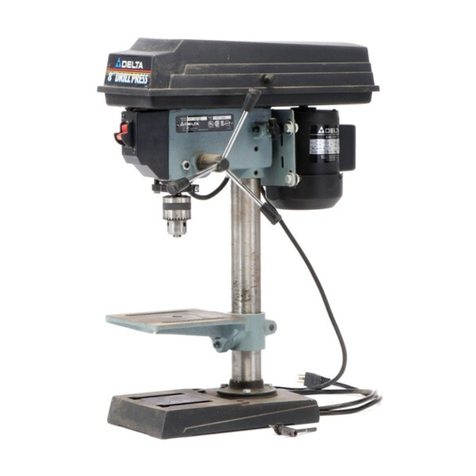
Delta
Delta 11-950 User manual
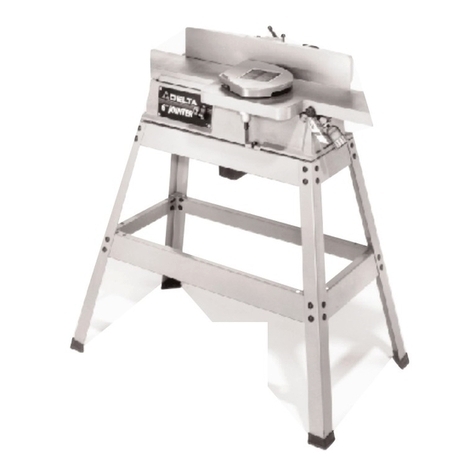
Delta
Delta 37-285 User manual
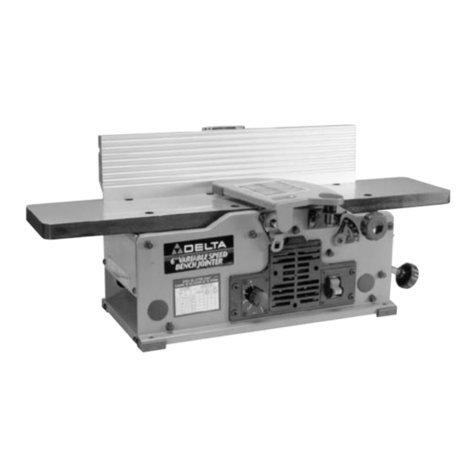
Delta
Delta 37-070 User manual

Delta
Delta 43-435 User manual

Delta
Delta E Series User manual

Delta
Delta ShopMaster DP250 User manual
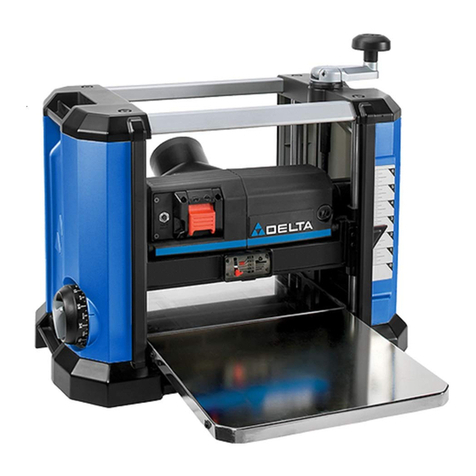
Delta
Delta 22-590X User manual
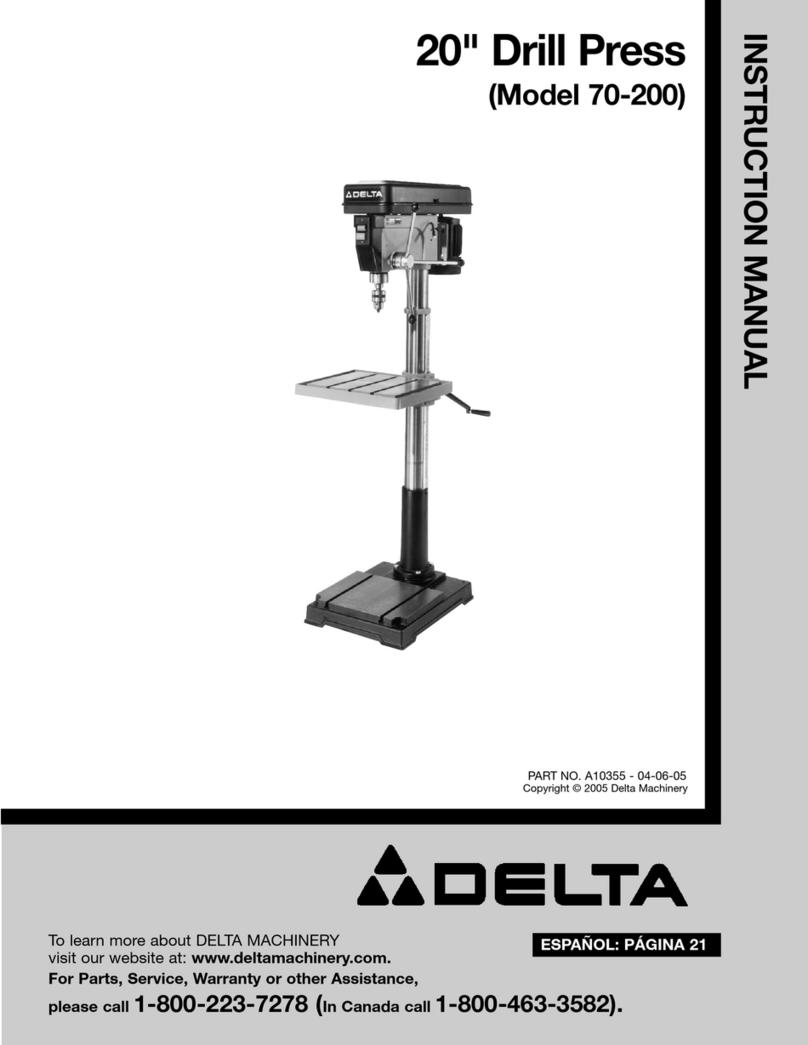
Delta
Delta 70-200 User manual
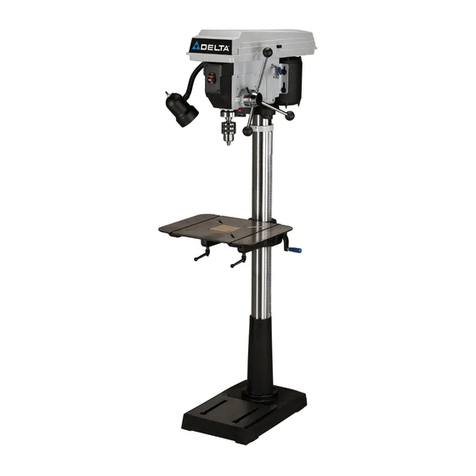
Delta
Delta 17-950L User manual
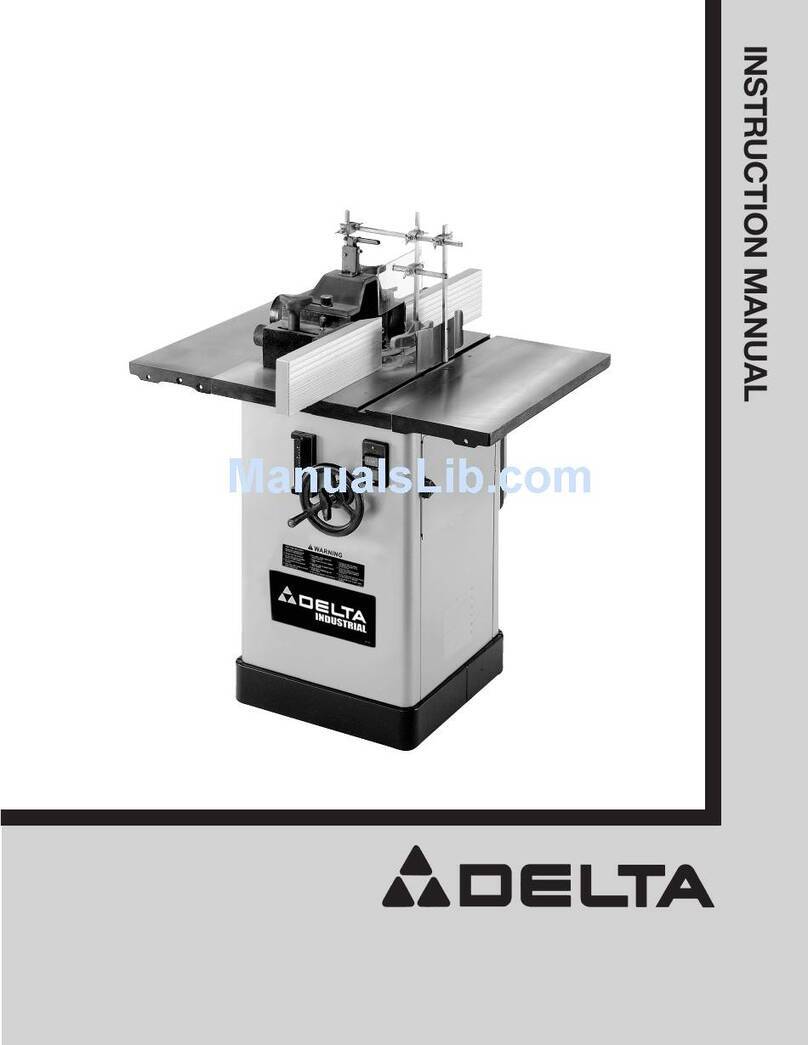
Delta
Delta 43-460 User manual
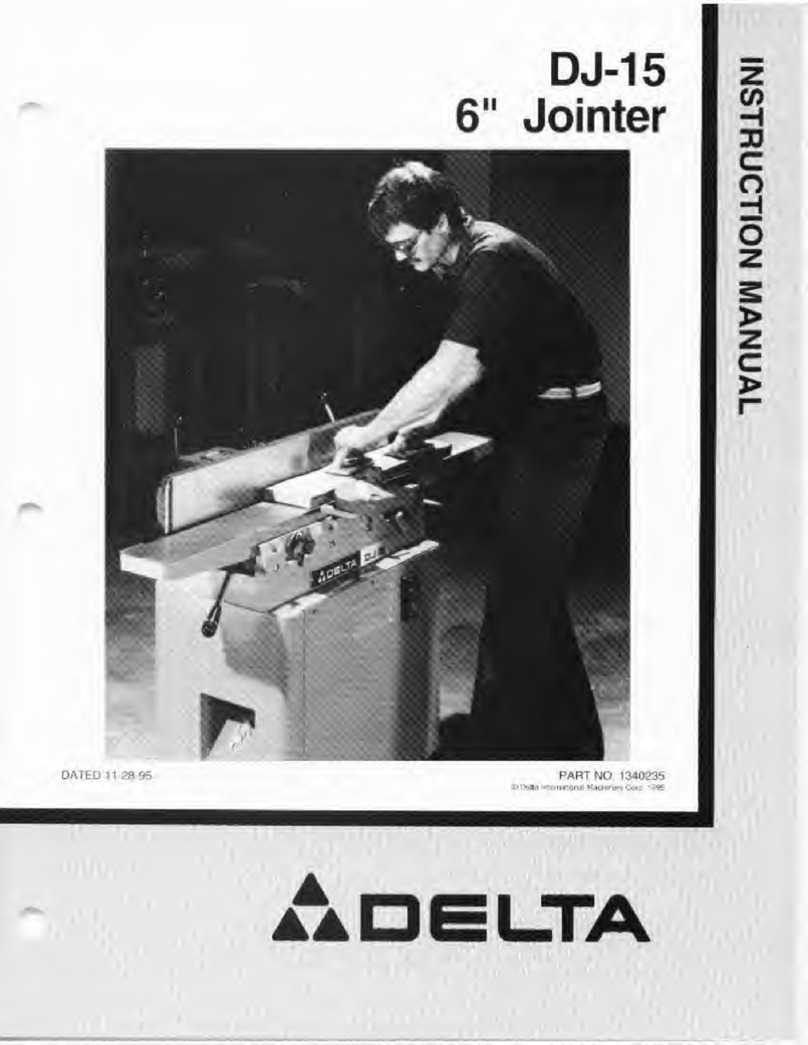
Delta
Delta DJ-15 User manual
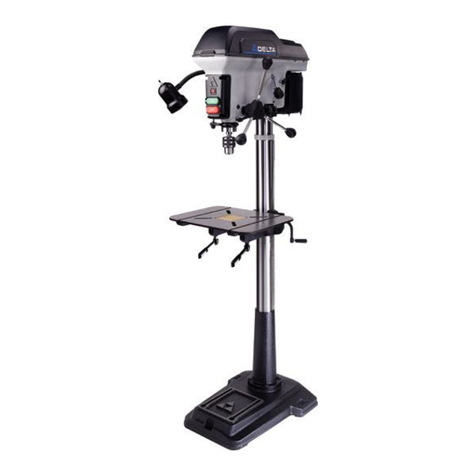
Delta
Delta 17-959L User manual
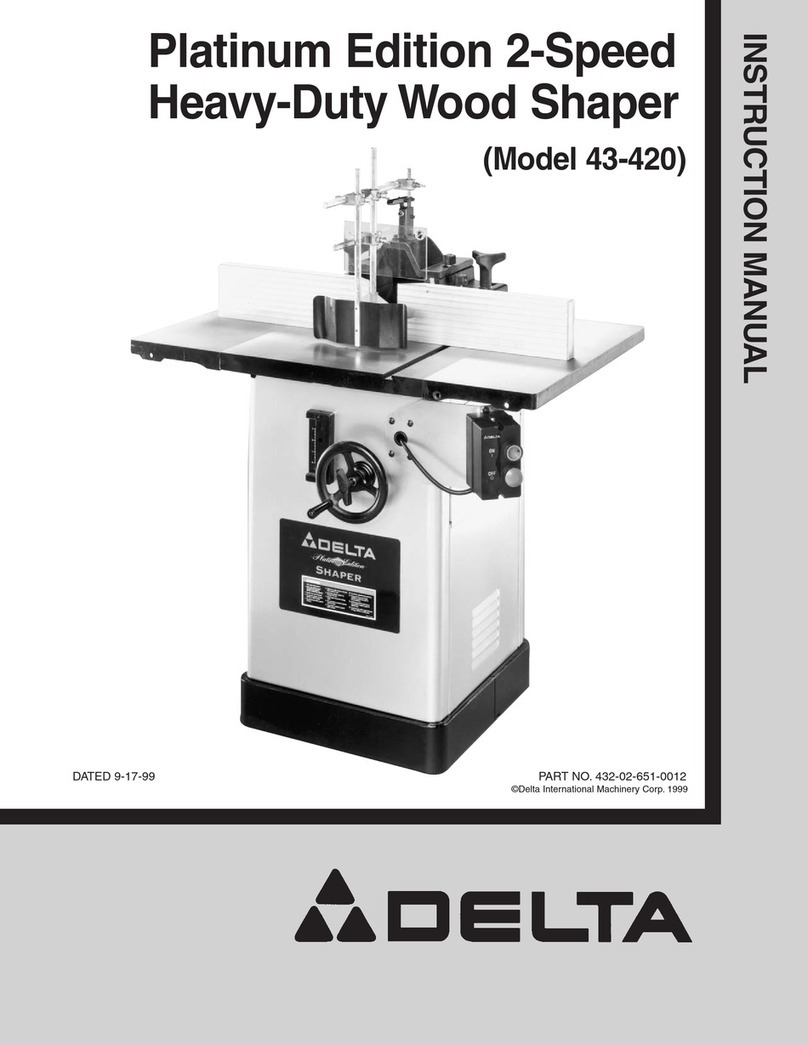
Delta
Delta Platinum Edition 43-420 User manual
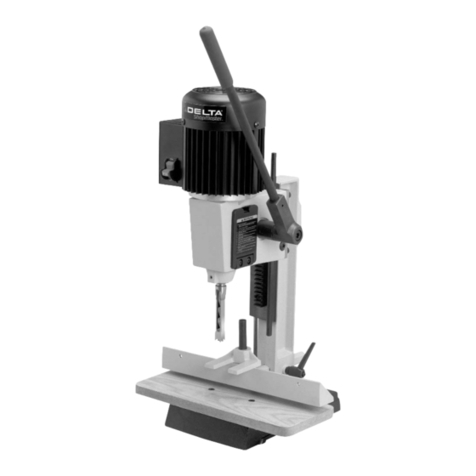
Delta
Delta ShopMaster MM300 User manual

Delta
Delta 14-651 User manual
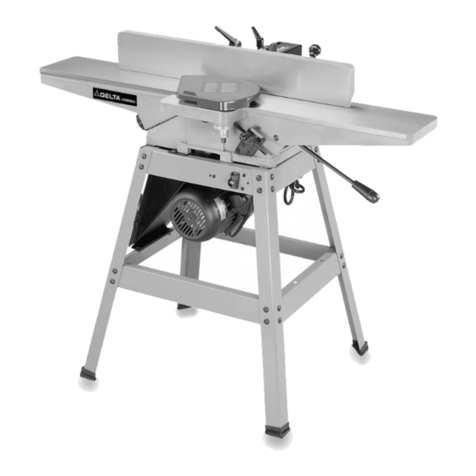
Delta
Delta Delta JT360 User manual

Delta
Delta 37-280 User manual
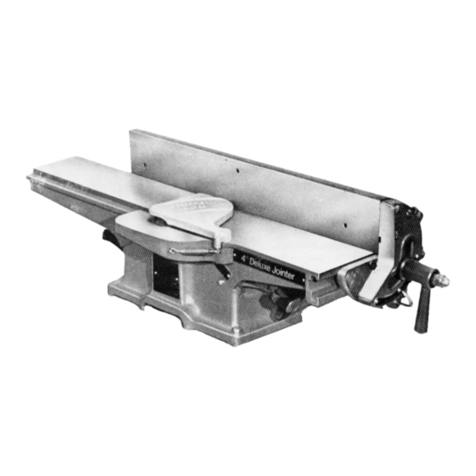
Delta
Delta 4'' Jointer User manual
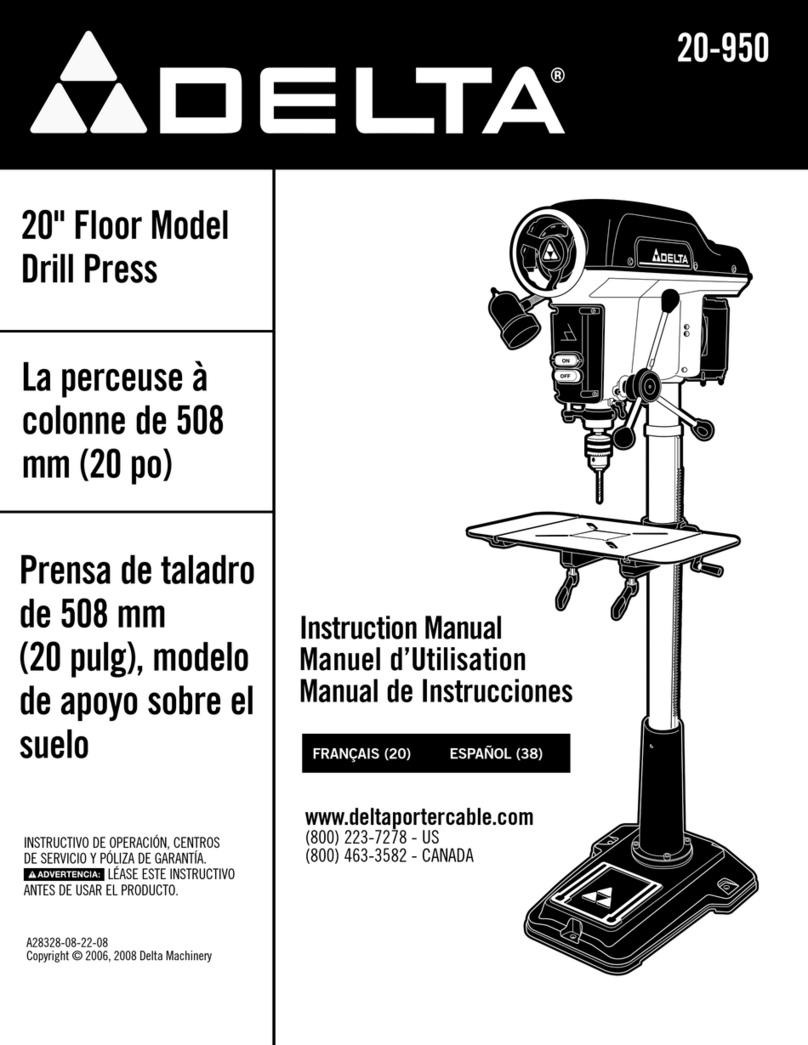
Delta
Delta 20-950 User manual

Delta
Delta DJ-30 User manual
